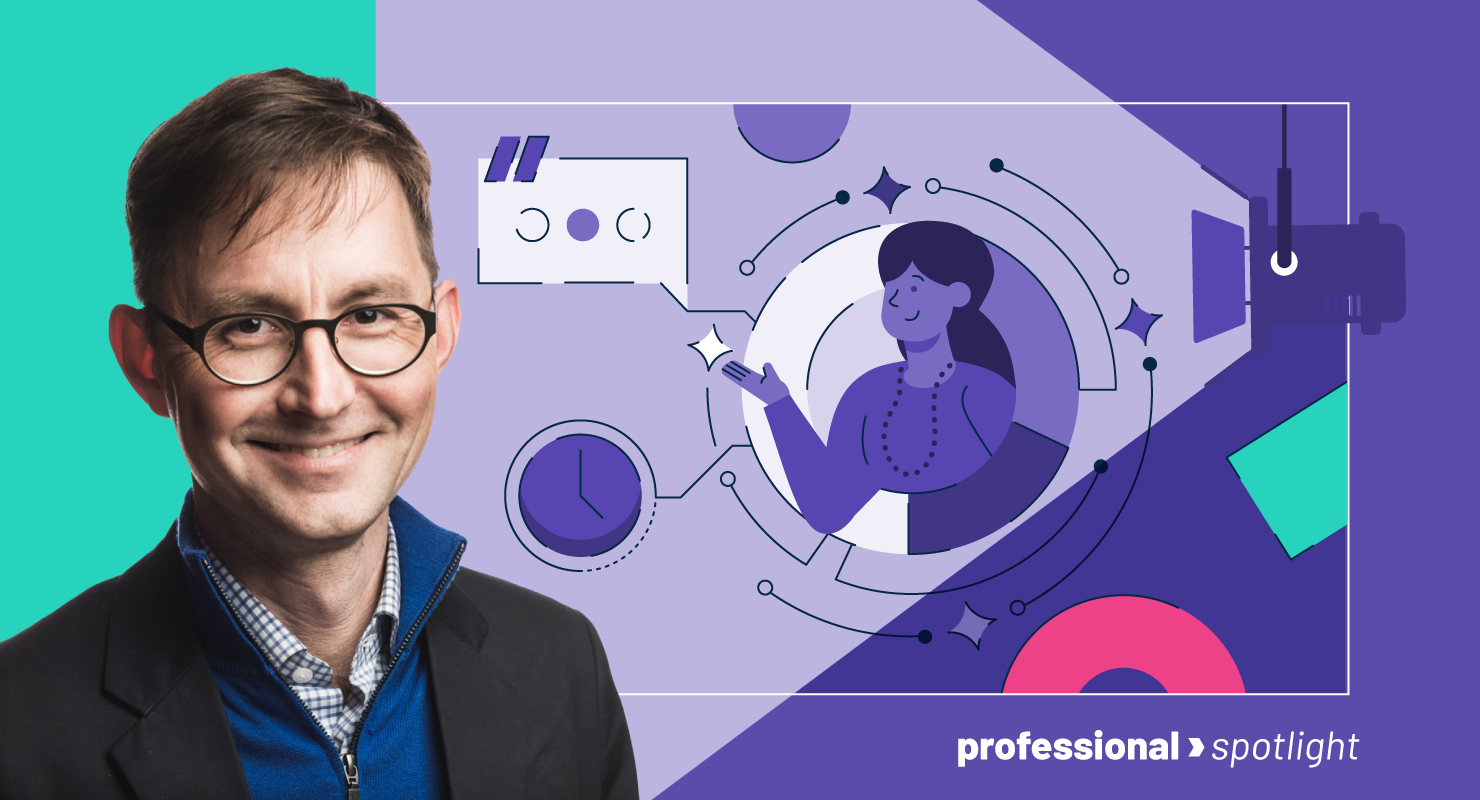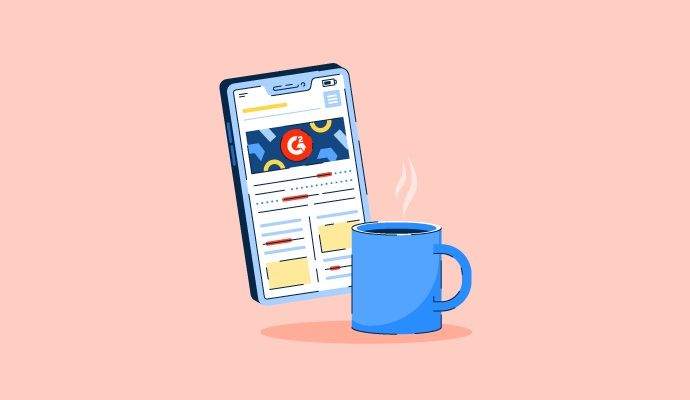September 18, 2024
 by Sidharth Yadav / September 18, 2024
by Sidharth Yadav / September 18, 2024

When you create a sales web page, you want to listen to your customers (literally).
“The best-converting B2B service pages emulate a sales call between a prospect and a salesperson,” says Andy Crestodina, a content marketing expert with 24 years of experience.
When the web page answers all the questions a user may have, it builds trust. Users start believing the company knows them as if reading their minds.
This cements the bedrock of sales: customer trust.
A robust content program forms the backbone of these sales pages. You build it, piece by piece, by producing original research over the years. Once built, it helps you win in search.
I chatted with Andy Crestodina, Co-founder and CMO of Orbit Media, a digital agency in Chicago, about what works in content marketing in the AI age. He also reveals some surprising patterns in how users interact with B2B websites and the key ingredients of a successful, 100% organic strategy.
“AI itself will be a new source of website traffic.” Why does Andy believe so? Find out below.
This interview is part of G2’s Professional Spotlight series. For more content like this, subscribe to G2 Tea, a newsletter with SaaS-y news and entertainment.
What's your favorite beverage? When do you enjoy it?
For the last few years, I've been meeting friends at the tasting room of a local distillery. The beverage is whiskey, so the drinks are strong, and I can't stay there for very long. But I play chess most Fridays at the tasting room with a whiskey and friends, and I'm home in time for dinner.
What was your first job?
I studied a foreign language and trained in college to be a teacher. But I did not become a teacher. I finished my certification and became an IT recruiter, helping programmers find jobs. Ironically, today, I'm very much a teacher. The best content marketers are teachers.
Early in my career, when training to be a teacher, I learned things like curriculum development and setting learning objectives, skills that I still use today.
My actual first job was working in restaurants, offering service. I started when I was 15 and did it all through high school and college. I still offer service today but as part of the digital agency.
Service is something we offer even today as part of the digital agency.
There are three main skills in our industry: creative, technical, and service skills. What we do today is not unlike restaurants. I was always a front-of-the-house person in restaurants. And in some ways, I'm still a service person.
What's your favorite software in your current tech stack?
The most exciting tool is simply ChatGPT because it has so many use cases. I also use SEO tools and Google Analytics.
What problems at work make you want to throw your laptop out the window?
When you ask someone who hired an SEO consultant what they thought the consultant did every day, they often have no idea. It's very strange how the buyer of SEO services is such a low-information buyer.
This is partly why the SEO industry gets away with so much nonsense: buyers of services don't even know what those services specifically do.
If you hire a web designer, you know what they do. You also know what a branding person does. But people hire SEO professionals every day with little idea what that person's job is. It's frustrating to see people wasting money but not doing half the job to understand what they bought.
SEO is not a box you check and get away with. There exist different SEO services for technical issues, keyword-focused content, and outreach.
Search rankings are the outcome of hundreds of possible actions a person can take. The actions that are most likely to lead to that outcome for that brand, that audience, that website, and that content are different across verticals.
The biggest mistake isn't wasting time educating prospects during the sales process. The bigger mistake is the waste of time when someone asks to buy a service from you that you don't really offer or sets expectations you can't meet.
Sidharth Yadav: You started your career as a recruiter and later cofounded Orbit Media Studios. What inspired you to make the shift to digital marketing?
Andy Crestodina: The Internet at the time was an open opportunity. A popular tool called Flash was used to make interactive tools, CD rounds, and web content.
And I wanted to use it to make interactive media for comic books and children’s education. I thought that was an interesting way to combine art and science. I wanted to use both halves of my brain all the time: the creative and the technical sides, the art and the science.
However, there wasn't enough market for us to start an interactive comic book company. My friend from high school had been building websites since the late 90s. So, I joined him as a designer while he was the programmer.
That evolved into us creating websites. That’s when my role evolved from being the designer and project manager to hiring other designers and project managers. My job became about helping these websites improve performance. It was a natural evolution from being trained as a teacher, trying to make educational interactive content, to making websites and becoming a marketer. It was not the plan, but that's how it happened.
Recruiting was really just a day job. It was helpful in part because I talked to people all day and learned to sell. Gradually, I understood how the search works.
I had no resume or portfolio at the time. I had no chance of getting a job. It's easier to start a company than to find a job. Of course, after you start a company, you have to find clients. However, the clients take smaller risks than a hiring manager. If a client hires you and you don't work out, they lose a bit of money. If a company hires you and you don't work out, they lose a lot more money and time.
With your understanding of audience behavior, what are some insights about user behavior patterns you find most surprising or counterintuitive?
This might be surprising for many: if you go to Google Analytics and create an exploration path showing the reverse path to your contact forms and ‘thank you’ page, you will find that the most common leads on your website go from your homepage to your contact form to your thank you page. It is common to see an extremely short path.
Everyone assumes that every pixel matters and visitors will read every word, which is true, but in the end, you'll find that the intent of many visitors is transactional. People who convert into leads do not read much or see that many pages.
That doesn't take away from the pixel-perfect perfection and wordsmithing of every paragraph because a percentage of visitors will read every word. It matters to be detail-oriented, publish in-depth content, and use great visuals to make videos. However, the most common leads on most B2B lead generation websites have very short visits with very few page visits.
People talk about conversion copywriting, upgrading formats, and creating frictionless experiences, but the visitor’s intent is the most important. You can’t change it. You can do little things like providing triggers and supporting evidence in the form of social proof. Ask yourself: Does the person truly need what you offer?
Can you describe your process for conducting audience research, and how do you translate these insights into actionable strategies?
Every project begins with detailed stakeholder interviews. These include interactions with clients, sales teams, and, when possible, actual customers.
You try to get to their emotional triggers and deepest needs. Then, you create content and build pages that speak directly to that customer as if they're on a sales call. The best-converting B2B service pages mirror a sales conversation between a qualified visitor or prospect and the top sales representative.
You must ask yourself what the visitor is most likely to ask on a sales call and build pages providing those answers. The visitor then feels you’ve read their mind. They start believing the company knows them well and understands their problems. You must follow an empathetic approach. You can’t make a good web page until you know the information needs and emotional triggers of the visitor.
Otherwise, you're just saying what you think you should say and not what your audience needs to hear.
You’ve stressed the need for brands to look more human and personal. How can they ensure this in the age of AI and automation?
Use pictures of your team. Anything your team believes in, put quotation marks around it. Upload a video of you explaining why your company exists and the story behind it.
“Tell a story, and you're automatically different from AI because AI has no world experience.”
Andy Crestodina
Co-founder and CMO of Orbit Media
Express an opinion, and you're automatically different from AI because AI has no point of view. Show your face and be human.
It's a matter of telling stories, taking a stand, offering strong views, having a tone of voice, and using quotation marks. It includes anything that makes your brand more personal and differentiates you from companies trying to take shortcuts by using AI-generated copies.
You’ve said the goal of B2B content strategy is to get service pages to rank and generate leads. It’s easier to track the business outcome of such pages. But for blogs and original research, which help boost site authority, this can be difficult. How can marketers present a convincing business case for them?
Content marketing has super powerful indirect benefits, but sometimes executives don't like dotted lines. They want every line to be straight. They only want to talk to qualified visitors.
But if you don't have a content program and you're not publishing content that's worthy of attracting links, then you'll have a site with a low domain authority. A site with low domain authority means your service pages won't rank for the valuable commercial intent key phrases, and you'll have fewer qualified visitors and leads.
Sometimes, it helps to show competitors’ cases. Marketers can show the company’s top competitors and how they rank high and have a higher domain authority. You realize they have a lot of links directing to their content program.
Your sales page is an ad. People link to helpful, useful articles, including thought leadership and original research. It’s very hard to compete with a brand that has 10,000 websites linking to it. If you don't have a content program, your only hope is to buy ads. You'll never win in search without an active content marketing program.
It takes time to start seeing traction. However, once the flywheel turns, I could stop the marketing and still generate qualified leads for years because the castle is built on a content program. Search rankings, social followers, and email subscribers are not going anywhere.
“The benefits of content marketing are cumulative, which makes companies with strong content programs very difficult to compete with.”
Andy Crestodina
Co-founder and CMO of Orbit Media
Let’s also recall that Google has never ranked a website; it only ranks web pages. But any link to any URL on your domain will improve the ranking potential of every URL on your domain. So, if you want your service pages to rank for competitive keyphrases, you need a domain with lots of authority and links.
There are two main search ranking factors: authority, which is links from other websites almost always directed to content programs, and relevance, which is about keyword-focused articles and service pages. Either of the factors separately is insufficient. You have to run them together.

Every Thursday, we spill hot takes, insider knowledge, and news recaps straight to your inbox. Subscribe here
Orbit follows a 100% content-driven approach to marketing without investing in advertising. What’s the idea behind this approach, and how do you strategize for its success?
We have never bought an ad. I'm sure it's effective. I just don't know anything about advertising. Our approach to marketing has always been through inbound and organic channels. So, we've done SEO for a long time and have had a content program for 17 years. We have eight million dollars in revenue without ever buying an ad.
We do a lot of offline marketing, such as live events and conferences. We also wrote a book. We’re active on podcasts and have a presence on LinkedIn and YouTube. Together, these create enough brand awareness for marketing leaders to remember us.
As I mentioned, you have to be dedicated and focused on inbound channels and stick with them long enough to get traction.
The pages need to be optimized for conversion by emulating sales conversations, addressing objections, answering questions, and adding supportive evidence. You need a good cheese and a mousetrap, but you don't need to pay.
The B2B content strategy has evolved over the years. It has moved from being blog and newsletter-driven to include seminars, account-based approaches, and social media engagement. Where do you see the evolution of content strategies going in the coming years?
In the future, visitors will use different channels when looking for answers and insights. Some people will stop using Google and start using AI just to get quick information. Therefore, click-through rates and traffic from search engines will decline.
But this doesn't mean that fewer people need answers. AI itself will be a new source of traffic for lots of websites.
Although click-through rates from AI may not be high, AI applications can still mention you if you are active in training AI.
“You can successfully train AI apps to recommend and trust your brand when providing answers.”
Andy Crestodina
Co-founder and CMO of Orbit Media
However, there will still be many key phrases for which the searcher intends to visit the website. AI will not impact these phrases. Users might look for a possible partner, research options, view case studies and testimonials, or read about the values of the founders on the website.
Some of the foundations will remain unchanged despite the disruptions. You will still need a place to show your values in your work and post your content and thought leadership.
As technology and consumer insights improve, people may expect more personalized experiences when they land on websites. Experiences will improve through technology. The pages will get better at reading the visitor's mind. Thus, the fundamentals of copywriting and understanding your visitors remain the same.
It’s not far-fetched anymore to imagine a future where AI develops consciousness and people start trusting it more.
People also wouldn’t stop trusting influencers. Just because there's AI doesn't mean you stop listening to people you believe and trust.
You will still likely trust people around you more than you trust an algorithm because you know them and feel a connection to them. Similarly, you will likely still trust content created by someone you know.
“The value of personal brands will go up. As the flood of AI content waters down a lot of what people see, when you see something from a person that you know, you’re likely to value it still.”
Andy Crestodina
Co-founder and CMO of Orbit Media
If I know you're smart, relevant, and an expert on a topic, and you tell me something about that topic, I'm listening. It's hard for me to imagine that trust in human influencers would change.
Social media did not reduce the importance of friendship or personal interactions. So just slow down, step back, and look at what is fundamentally true, and you may find that comforting.
What are some of AI's most underutilized but high-potential use cases in marketing? How can marketers choose and implement these?
If you train AI on your persona, give it a piece of content, and ask what’s missing based on your persona's point of view, it will tell you. You can even get recommendations to make it better.
Give it your homepage. I recently asked AI: To what extent does this page meet the information needs of my visitor?
When we looked at the page, it seemed fine. But AI showed it lacked testimonials, evidence, and statistics. Safety concerns mattered to the visitor of that page, and the page didn’t talk about them.
Another one, of course, is to upload data. If you have permission to upload anonymized data, you can get useful insights. For instance, you can upload the pages and screens report containing URLs, traffic sources, and mediums. Then, ask AI to summarize your content strategy, tell you which topics work in which channels, and suggest new topics. You can ask it to do a semantic distance analysis on everything you’ve published. Finding gaps in a giant body of work like this is humanly difficult.
AI is a fantastic tool for content strategy as long as you give detailed information about your prospect and disregard most of the responses. You’re only looking for a few nuggets.
You can use AI to help trigger ideas. Then, you do the hard work of taking a stand, writing strong opinion pieces, conducting original research, doing outreach, and gathering survey data.
I use AI to find deficiencies and make something better than my competitors. I don't need to be faster; I need to be better.
Follow Andy Crestodina on LinkedIn to keep tabs on the latest trends in content marketing and SEO.
Did you know that 75% of AI buyers see first-year payoffs? Unlock more such insights on software use in our latest State of Software report.
Sidharth Yadav is a senior editorial content specialist at G2, where he covers marketing technology and interviews industry leaders. Drawing from his experience as a journalist reporting on conflicts and the environment, he attempts to simplify complex topics and tell compelling stories. Outside work, he enjoys reading literature, particularly Russian fiction, and is passionate about fitness and long-distance running. He also likes to doodle and write about employee experience.
Inbound, outbound, or a combination of both? This question stares at B2B growth marketers yet...
 by Sidharth Yadav
by Sidharth Yadav
Let’s address the elephant in the room: No marketing campaign performs equally well as the...
 by Tanushree Verma
by Tanushree Verma
Most B2B marketers think buyers are rational first and emotional later. They are wrong.
 by Sidharth Yadav
by Sidharth Yadav
Inbound, outbound, or a combination of both? This question stares at B2B growth marketers yet...
 by Sidharth Yadav
by Sidharth Yadav
Let’s address the elephant in the room: No marketing campaign performs equally well as the...
 by Tanushree Verma
by Tanushree Verma


